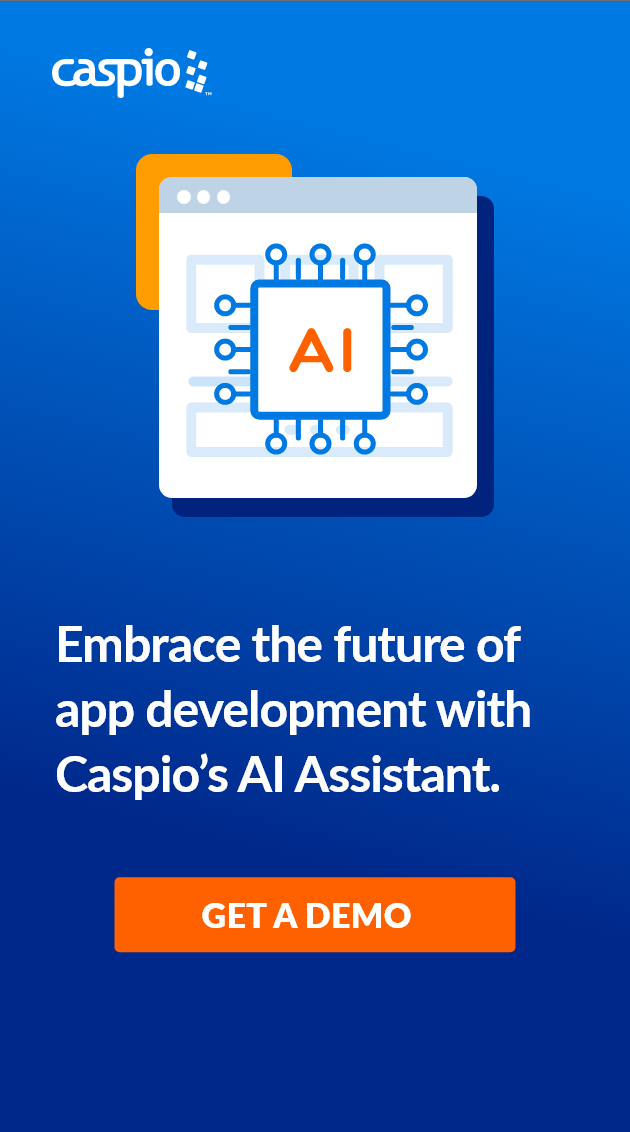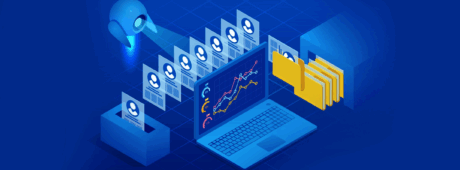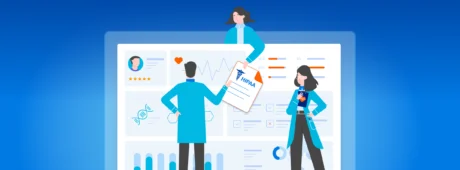Building an AI-Enhanced Applicant Tracking System With No-Code
August 27, 2025
An applicant tracking system (ATS) is a type of HR software used to publish job openings, collect applications and manage the recruitment process in one centralized database. It replaces fragmented tools like spreadsheets, shared drives and email with a single platform for managing the recruitment process.
In this guide, we’ll explore how to design an AI-enhanced ATS using Caspio’s no-code platform, including the essential components, benefits of a no-code approach and the role of AI in improving candidate evaluation.
Why Build a No-Code ATS?
Traditional ATS platforms can limit hiring teams in three key ways:
- High per-user licensing fees that increase as the team grows.
- Fixed workflows that are difficult to adapt to unique processes.
- Reliance on vendor support for even minor changes.
Caspio’s no-code platform removes these limitations by providing:
- Rapid development: Visually design and deploy your ATS in days.
- Unlimited users: Every plan includes unlimited app users at no extra cost.
- Full customization: Adapt forms, dashboards and workflows to your hiring process without coding.
- Built-in automation: Trigger notifications, filter job boards and manage role-based access.
- Integrated AI capabilities: Use Caspio’s AI extension to score resumes, summarize candidate fit, generate interview questions, and draft job descriptions without custom code.
- Enterprise-grade compliance: HIPAA, SOC 2, GDPR, PCI, FERPA and more.
- Flexible deployment: Host on a Caspio domain or embed directly into your own website.
Architecture: From Data to Deployment
A strong ATS starts with a structured data model. In Caspio, this includes defining tables for candidates, job postings, interview feedback and more. With Caspio’s AI Assistant, you can create tables and fields using natural language. Simply describe your data needs in plain English, and the AI Assistant generates the table structure for you in seconds.
- Jobs table: Job postings with title, description, department, location, type and status.
- Applicants table: Candidate information, resumes, AI match scores and fit summaries. When a candidate applies for or is considered for multiple jobs, these records link to separate entries in the Applications table.
- Applications table: Links candidates to specific job postings and tracks application dates, statuses and related activity.
- Interviews table: Interview schedules, notes, scores and recommendations.
- Lookup tables: Standardized values like departments, employment types and statuses.
These tables are linked through relationships, so data flows seamlessly. For example, Job ID in the Applicants table connects to the Jobs table, ensuring HR teams can quickly view all applicants for a specific posting.
Role-based segments, managed through Caspio Directories, create tailored experiences for:
- Public users, or the job seekers.
- HR staff managing postings, applications and interviews.
- Interviewers assigned to evaluate candidates.
Designing the User Experience
With Caspio’s Flex App Designer, you can visually build interfaces for each user role:
- Public job board: Searchable and filterable listings with details pages and application forms.
- HR dashboards: Manage jobs, review AI scores and schedule interviews from one place.
- Interviewer portals: Access assigned interviews and submit evaluations.
Caspio’s overlay windows appear as pop-up screens, allowing users to complete tasks such as editing job postings or scheduling interviews directly on the same page, thus speeding up workflows.
Leveraging AI for Better Candidate Evaluation
With Caspio’s AI extension, AI becomes an integrated part of the ATS workflow, enabling advanced capabilities without writing code. You can configure AI to:
- Compare resumes to job descriptions and return a match score (0–100).
Sample Prompt: You are a recruitment assistant. Compare the attached job description and applicant resume, and return: A match score from 0 to 100.
- Provide a fit summary highlighting key alignment or gaps.
Sample Prompt: You are a recruitment assistant. Compare the attached job description and applicant resume, and return: A one-sentence summary of how well this applicant fits the role.
- Draft complete job descriptions from a short prompt or position summary.
- Craft tailored interview questions for each interviewer role and distribute them so interviewers avoid asking the same questions.
Sample Prompt: You are an experienced recruiter and hiring manager. I will provide you with a detailed job description. Based on this description, create a list of tailored interview questions that assess the candidate’s technical skills, industry knowledge, problem-solving abilities and cultural fit. Include both behavioral and situational questions, and make sure they align with the specific requirements and responsibilities outlined in the job description. Organize the questions into sections (e.g., Technical Skills, Behavioral, Situational, Role-Specific) and provide 5–7 questions for each section. Do not repeat similar questions.
- Summarize interview feedback by first combining responses from multiple interviewers into a single record, then prompting AI to produce a clear hire/no-hire recommendation based on your internal criteria.
All AI outputs are stored directly in your Caspio data tables, making them accessible in HR dashboards, applicant records and automated workflows.
Want to see other ways AI can accelerate application development? Explore 10 Ways to Use AI With Caspio for more ideas you can apply beyond recruiting.
Orchestrating Workflow Logic
Caspio’s automation tools reduce repetitive work and ensure data security:
- Auto-emails: Send a customized AI generated email to the candidate confirming the receipt of their application.
- Triggered actions: Send internal Slack notifications when applications are submitted or statuses change.
- Conditional filters: Automatically hide inactive jobs from the public job board.
- Record-level security: Ensure interviewers only see their assigned candidates.
These features keep the hiring process moving smoothly while protecting sensitive information.
Deployment and Iteration
Once your ATS is ready, you can:
- Host it on a Caspio-provided subdomain.
- Embed it into your existing website with a snippet of code.
- Integrate it with internal systems using SSO.
- Connect with other tools via Caspio’s REST API or webhooks.
Caspio makes it easy to connect your ATS with the rest of your HR tech stack using built-in integrations, webhooks and REST APIs, all without writing code. This means you can unify data across systems, automate cross-platform workflows and keep every part of your recruitment process in sync.
Because the application is modular, you can add features over time, such as applicant portals, document generation or Slack integration, without starting from scratch.
Final Thoughts
By combining Caspio’s no-code platform with AI capabilities, HR teams can build an ATS that’s scalable, compliant and tailored to their exact needs, without waiting on vendor timelines or paying per-user fees.
Ready to explore what’s possible? Start your free trial or schedule a demo to see how quickly you can launch your own AI-enhanced applicant tracking system.















